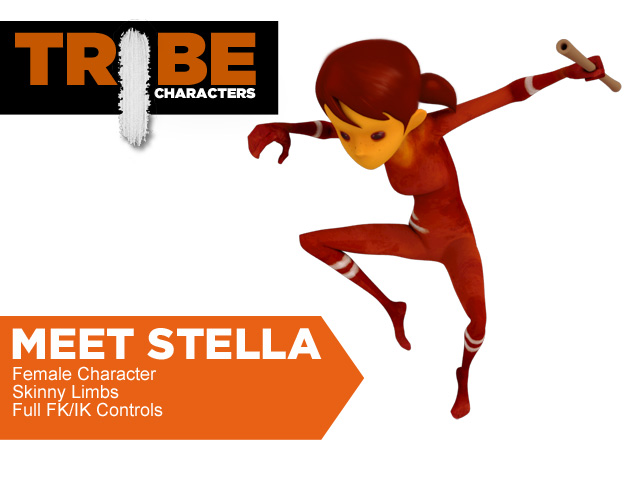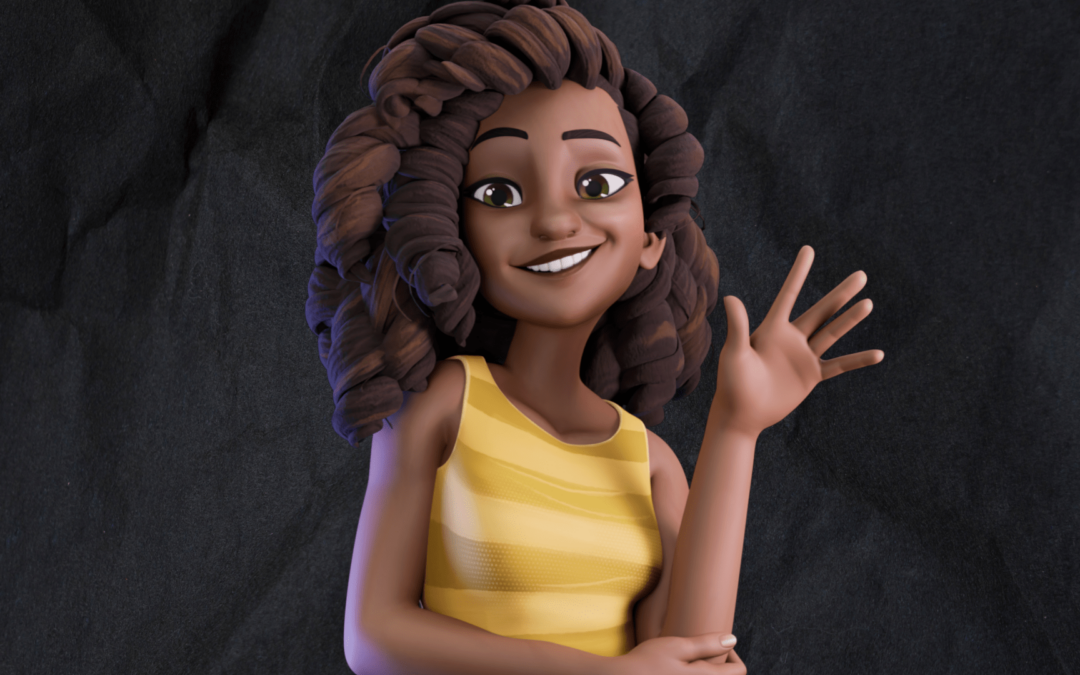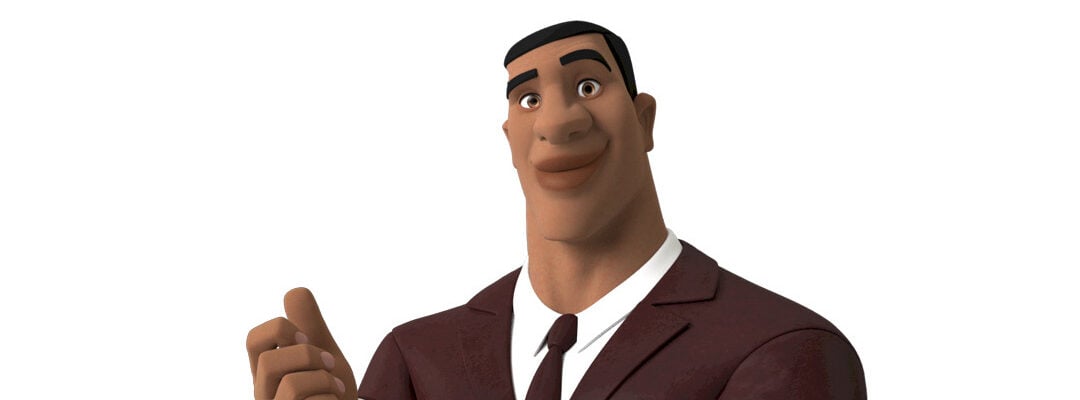
Just last week, our CEO, Bobby Beck, introduced us to a new member of the character tribe: Stan. We continue the chat with today’s character introduction of Stella. Bobby also selected a student animation that showcases Stella and her unique characteristics. Stan and Stella are available to all Animation Mentor students — past and present — starting in our Animation Fundamentals. Enjoy.
— The Animation Mentor Crew
Why was Stella created?
Bobby: She brings a strong female character to our character tribe. She’s feminine, yet also has on the tribe war paint which gives her a bit of an edge and confidence. We wanted to be mindful that we actually created Stella — a female character — and not just created a modification of a male character. We wanted to make sure that our students could learn to animate the full characteristics of a female right out of the box.
What makes the Stella rig so different?
Bobby: The controls across all of our rigs are standardized — that is very important. We want our students to feel comfortable animating, especially when they move from one character to the next. We made Stella very fluid and fleshy with full FK and IK controls for her spine, arms, and legs. We designed her with FK/IK snapping and FK/IK blending over frames as we have with the other tribe characters as well. She’s really amazing to work with and her skinny limbs allow for some really great shapes when posing.
What excites you most about Stella?
Bobby: Stella is a great design. The core of a great design is when you look at it and it excites you and you ask yourself, “What can I come up with?”; “What can I create?”; “What inspires me?” To energize students to push themselves, we have to create characters that are appealing and exciting to work with. So when you look at a character, you get inspired — and then you say, “Wow, what do I want to do?”
Student shot featuring Stella: Thomas Stockinger
Bobby: We purposely designed Stella without any facial controls, just blinks. We want students to focus on all that you can get out of great pantomime. This really emphasizes the performance and acting. Walt Disney himself was a fan of this approach. He was quoted for making shots final that didn’t have facial animation because he felt so much of the acting was in the pantomime and overall body performance.
For Thomas’ shot, you sense Stella’s nervousness right away. You can tell that she’s trying to collect herself. She’s caught in the moment. You see a range of emotion — shock, surprise, embarrassment — and then her dashing away. This shows great texture, timing, and rhythm. I love the breathing points. A lot of times, people rush rush rush from one pose to the next. You don’t see that here and it’s really refreshing to have those pauses and the result feels more sincere and entertaining. You can actually enjoy the scene.
Thomas Stockinger: It is so inspiring and motivating
Animation Mentor student Thomas Stockinger talks about working with Stella and the overall Animation Mentor experience.
What did you think when you first saw Stella?
Thomas: I immediately liked her and found that she was very appealing. She looks smart, strong, and cute at the same time and I just felt that she was a good sport.
How did you concept your shot and how was it to animate?
Thomas: In the week we had to submit our idea for the pantomime shot, I really had a blast and acted out and edited five different ideas and made thumbnails for two of them. I ended up doing this shot because it looked pretty clear from the beginning, I liked how the video reference came out quite funny, it had a good contrast in tempo, and it seemed like a good opportunity to implement what I had heard about phrasing and texture in the last term. I knew there had to be a different quality to her movements and posture before and after the door opened and I wanted to take the challenge to make that visible. I think her arms were set to align with the world for default so I thought I’d try that since she wasn’t spinning around like mad. It does have some advantages but I also realized that it can give you some weird rotations.
Since I discovered the Euler filter, I actually never had to struggle with gimbal lock of the arms anymore because I always had them follow the upper body. Their movement was limited and the filter always knew what to do — but having them in world space seemed to complicate things because they had to do their own rotations plus the rotations of the upper body which can lead to weird curves. In the end it wasn’t a big deal, but at some point I thought about aligning the arms to the upper body and doing all the keys again. So I guess you should use this alignment carefully and with planning, like an IK switch.
It wasn’t always easy to animate and I was really struggling at some points. At first, I had a different beginning. She was sneaking in, looking backwards, and I just loved the pose — it said so much about her inner struggle. But Erik Morgansen, my mentor, said it would be even stronger without that pose and he was so right. Instead of going from uncertain to determined and then to panic — she just goes from determined to even more determined and then to panic, which really works a lot better in a shot like this. You just can’t get too many things in there when time is so limited! All the hesitation was enough to sell her uncertainty, it didn’t need that pose in the beginning. It reads a lot clearer this way.
What is the best part about sharing your work with the Animation Mentor campus?
Thomas: That is probably the main reason why I’m doing this school, because I wanted to get feedback from other animators. Not that I wouldn’t care about other people’s feedback! Of course, our animations have to read for everybody, no matter what they know about animation but I figured other animators would know better about what could be done to improve the performance and would be more able to help me out with the problems I keep running into.
I never worked together with other animators and I felt it was important for me to get into an environment where I could share my thoughts, ask questions, and give and get feedback. They say you learn as much (if not more) from giving feedback as from getting it and I think that might be true. It’s a great way to practice your eye and focus on the principles and become aware of what works and what doesn’t. And I think pointing things out to others makes you even more aware of your own work — because you don’t want to be caught doing the same mistakes you’ve been criticizing in other people’s work, right?
And having somebody with fresh eyes looking at your work when you can’t really see it anymore is also so valuable! I took part in a working on animation session with Francis Emvula when I was polishing the shot and he immediately saw a knee pop that I would never have noticed otherwise — even though it was pretty obvious right in the beginning. I was so blinded by everything else that I just overlooked it every time I played the animation.
And last but not least — it is so inspiring and motivating to see what other people come up with, how different their approaches are, and how much work and passion they put into their animations. I think we really push each other a lot this way and that’s great!
Best,
Tom



